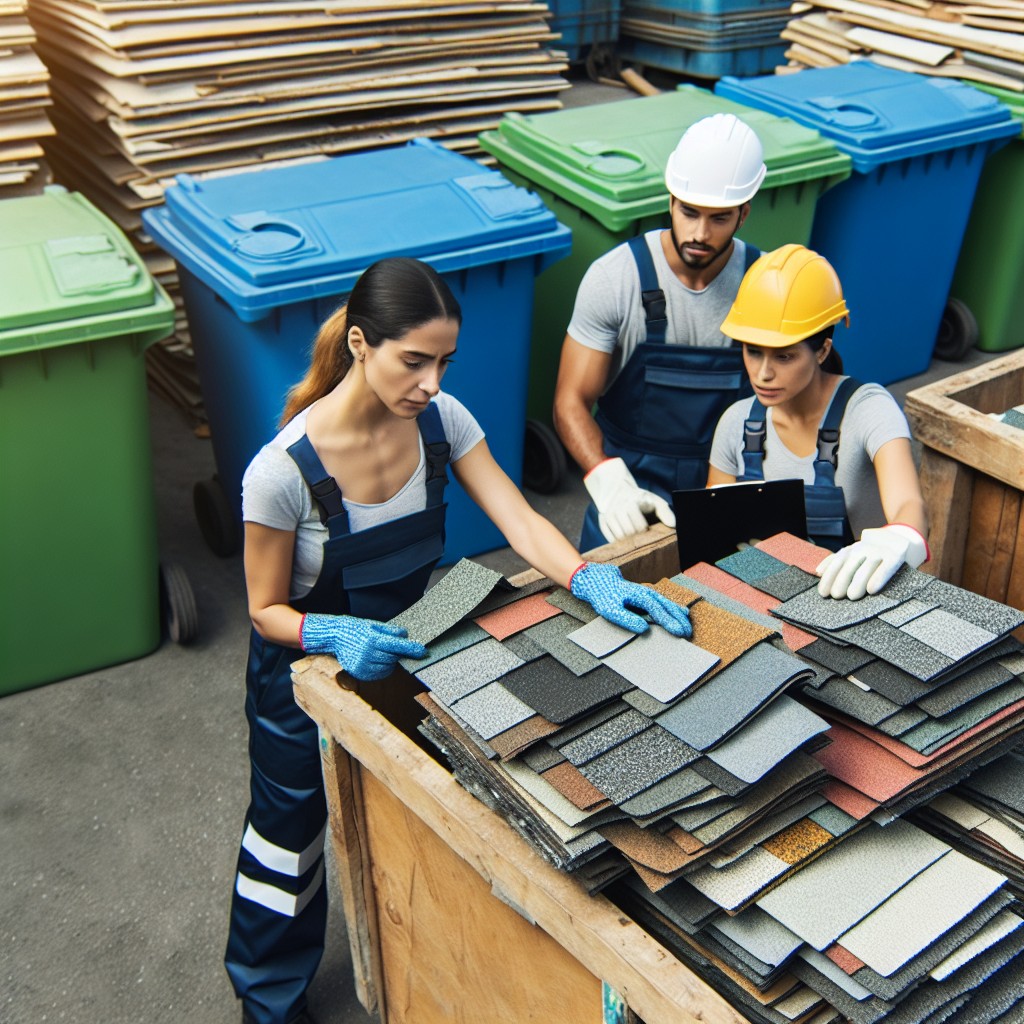Last updated on
This how-to article will guide you through the environmentally-responsible process of recycling shingles, presenting an innovative way to reduce construction waste.
Key takeaways:
- Determine shingle recyclability based on composition and condition
- Prepare shingles by removing debris and sorting by type
- Shingle recycling process involves sorting, grinding, and repurposing
- Recycling shingles reduces landfill waste and conserves resources
- Joining a recycling program saves costs and enhances reputation
Assessing Shingle Recyclability

Before recycling shingles, determine their composition and condition. Most asphalt shingles—the most common type—contain a mixture of fiberglass or organic materials, asphalt, and granules, and these are readily recyclable. Wood shingles, although less common, are also recyclable but typically through wood waste processors.
The presence of hazardous materials such as asbestos is a critical factor. Asbestos-containing shingles, common in homes built before the 1980s, require special handling and can’t be processed through standard recycling facilities. These must be disposed of in accordance with local hazardous waste regulations.
In assessing recyclability, consider the age and layers of roofing. Shingles that are overly saturated with roofing tar or covered in moss and vegetation might not be suitable for some recycling programs. Nails and other metal fasteners typical in roofing installation do not disqualify shingles from being recycled, as these can generally be removed magnetically during the recycling process.
Once you have established that your shingles are recyclable, connect with local recycling facilities to confirm their specific acceptance criteria, as these can vary by location.
Preparing Shingles for Recycling
Before transporting shingles to a recycling facility, remove any attached debris, such as nails and non-asphalt materials. Nails can often be separated with a magnet after grinding the shingles, but manual removal beforehand ensures a cleaner product for recycling. In addition, check with local facilities for specific pre-recycling requirements, as some may have strict contamination guidelines.
Sort the shingles by type since architectural shingles and three-tab shingles may undergo different recycling processes. Bundle the sorted shingles neatly to facilitate easy handling and transport. Keep in mind, reducing contamination during preparation is pivotal for protecting the integrity of the recycled material and ensuring it can be successfully repurposed into new products.
Finally, ensure the shingles are completely dry, as wet shingles can be heavier, harder to process, and more expensive to transport due to their increased weight. Proper preparation is a crucial step towards efficient recycling and contributes greatly to the lifecycle of roofing materials.
Shingle Recycling Process
Once collected, shingles undergo a comprehensive recycling procedure. First, they are sorted and contaminants like nails and non-asphalt materials are removed. The clean shingles are then ground into smaller particles. This material, primarily composed of asphalt, is repurposed in hot-mix asphalt for paving roads or as an input for the manufacture of roofing materials.
Innovative uses also include incorporating recycled shingle material into new shingles or using it as a dust control agent on unpaved roads. The process not only diverts waste from landfills but also reduces the need for virgin asphalt—a win for both industry and environment.
The Environmental Impact of Shingle Recycling
Recycling used shingles significantly reduces landfill waste as a typical roof replacement generates about 1 to 3 tons of shingles. The asphalt from these recycled shingles often finds new life in road construction, which each year uses up approximately 11 million tons of asphalt shingle material.
This not only lessens the need for raw materials but also results in the conservation of approximately two barrels of oil per ton of recycled shingles. By reducing the extraction of natural resources, shingle recycling contributes to lowering greenhouse gas emissions and energy consumption.
Furthermore, it supports environmental initiatives by giving communities a durable, cost-effective material for infrastructure development that has a smaller carbon footprint than many traditional road-building materials.
Benefits of Joining a Shingle Recycling Program
Participating in a shingle recycling program offers numerous advantages. It drastically reduces landfill waste, as the majority of recycled shingles are converted into road paving material, diverting significant volumes from landfills.
Cost savings arise from avoiding landfill fees, and in some cases, recycled shingles can be cheaper than virgin materials for new asphalt projects. Additionally, using recycled shingles in road construction can enhance pavement quality, thanks to the asphalt content in shingles.
Contractors may also benefit from potential tax incentives for choosing environmentally friendly practices. Finally, clients often appreciate sustainability efforts, which can bolster a company’s reputation and increase competitive edge in the market.
By engaging in shingle recycling, builders and roofers demonstrate a commitment to resource conservation and environmental stewardship.
FAQ
What can you use old roof shingles for?
Old roof shingles can be creatively reused to lay a mulch path, craft a doormat, construct a birdhouse, or act as weed deterrents around plants.
Can I put shingles in my garbage can?
Asphalt shingles may be disposed of in your garbage can, provided they have been tested and confirmed to be free from asbestos.
Are roof shingles considered hazardous waste?
Yes, roof shingles can be considered hazardous waste due to the potential release of harmful chemicals during their burning process.
What is the process for recycling asphalt shingles?
The process for recycling asphalt shingles involves collection, grinding the shingles to a small size, and then incorporating the ground material into hot mix asphalt paving mixture or using it as a portion of a sub-base or base material in civil construction applications.
How much waste is generally produced from reroofing projects?
Reroofing projects typically result in approximately 2 to 3 pounds of waste per square foot of roof area.
Can recycled shingles be utilized in pavement or road construction?
Yes, recycled shingles can be utilized in pavement or road construction, notably for hot-mix asphalt production and road cover.




